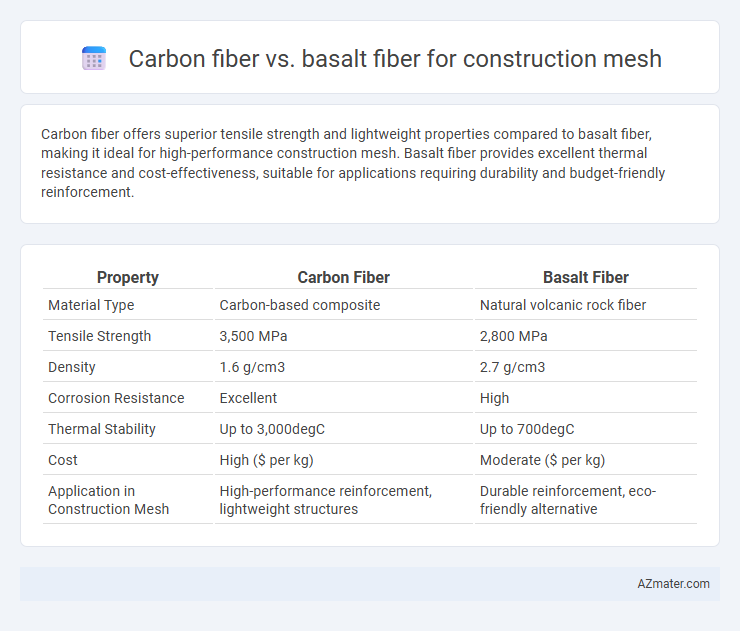Carbon fiber offers superior tensile strength and lightweight properties compared to basalt fiber, making it ideal for high-performance construction mesh. Basalt fiber provides excellent thermal resistance and cost-effectiveness, suitable for applications requiring durability and budget-friendly reinforcement.
Table of Comparison
| Property | Carbon Fiber | Basalt Fiber |
|---|---|---|
| Material Type | Carbon-based composite | Natural volcanic rock fiber |
| Tensile Strength | 3,500 MPa | 2,800 MPa |
| Density | 1.6 g/cm3 | 2.7 g/cm3 |
| Corrosion Resistance | Excellent | High |
| Thermal Stability | Up to 3,000degC | Up to 700degC |
| Cost | High ($ per kg) | Moderate ($ per kg) |
| Application in Construction Mesh | High-performance reinforcement, lightweight structures | Durable reinforcement, eco-friendly alternative |
Overview of Carbon Fiber and Basalt Fiber
Carbon fiber exhibits exceptional tensile strength, lightweight properties, and corrosion resistance, making it ideal for high-performance construction mesh applications. Basalt fiber, derived from volcanic rock, offers excellent thermal stability, chemical resistance, and cost-effectiveness, providing a durable alternative for reinforcement in concrete and masonry structures. Both fibers enhance structural integrity, but carbon fiber delivers superior strength-to-weight ratios, while basalt fiber excels in environmental resistance and affordability.
Material Properties: Strength and Durability
Carbon fiber offers exceptional tensile strength up to 7,000 MPa and boasts a high strength-to-weight ratio, making it ideal for demanding load-bearing construction mesh applications. Basalt fiber provides impressive durability with excellent resistance to chemical corrosion and thermal stability up to 1,000degC, enhancing long-term structural integrity under harsh environmental conditions. Both materials outperform traditional steel mesh in corrosion resistance, yet carbon fiber excels in strength while basalt fiber is favored for cost-effective durability.
Weight Comparison: Carbon vs Basalt Fiber Mesh
Carbon fiber mesh weighs approximately 1.6 grams per cubic centimeter, making it significantly lighter than basalt fiber mesh, which has a density around 2.7 grams per cubic centimeter. This weight difference enhances the ease of handling and reduces overall structural load when using carbon fiber in construction applications. Lightweight carbon fiber mesh is preferable for projects requiring high strength-to-weight ratios and improved installation efficiency compared to heavier basalt fiber mesh.
Corrosion and Chemical Resistance
Carbon fiber construction mesh exhibits excellent corrosion resistance, maintaining structural integrity in harsh chemical environments including acidic and alkaline conditions. Basalt fiber offers superior chemical resistance to alkalis and acids, outperforming traditional materials but may degrade under certain aggressive chemical exposures over time. Both fibers provide durability against corrosion, with carbon fiber preferred for extreme chemical resistance and basalt fiber advantageous in environments with moderate chemical exposure.
Thermal Stability and Temperature Tolerance
Carbon fiber exhibits superior thermal stability withstanding continuous temperatures up to 400degC, making it ideal for high-temperature construction applications. Basalt fiber also offers excellent temperature tolerance, resisting heat up to approximately 650degC without significant degradation, which suits it for fire-resistant mesh installations. Both fibers provide enhanced durability compared to traditional materials, but basalt fiber excels in extreme heat environments while carbon fiber offers better overall thermal stability and strength-to-weight ratio.
Installation and Workability
Carbon fiber construction mesh offers superior tensile strength and lightweight properties, making installation quicker and reducing labor costs on-site. Basalt fiber mesh provides excellent corrosion resistance and thermal stability, allowing for easier handling and cutting without specialized tools during installation. Both materials improve workability compared to traditional steel mesh, but carbon fiber's flexibility and durability often result in more efficient installation processes in complex construction environments.
Cost Analysis and Economic Considerations
Carbon fiber construction mesh typically incurs higher upfront costs compared to basalt fiber, with prices often two to three times greater due to its complex manufacturing process and superior tensile strength. Basalt fiber offers a more cost-effective alternative by leveraging abundant natural volcanic rock, resulting in lower raw material and production expenses while maintaining decent durability and corrosion resistance. Evaluating lifecycle costs reveals basalt fiber meshes reduce overall economic burdens in large-scale projects, though carbon fiber's enhanced performance may justify its premium for critical, high-stress applications.
Environmental Impact and Sustainability
Carbon fiber construction mesh exhibits high strength-to-weight ratio but involves energy-intensive manufacturing with significant carbon emissions, raising environmental concerns. Basalt fiber mesh, derived from abundant volcanic rock, offers eco-friendly production with lower energy consumption and excellent recyclability, enhancing sustainability in construction. Choosing basalt fiber reduces carbon footprint and supports green building initiatives more effectively than traditional carbon fiber alternatives.
Typical Applications in Construction
Carbon fiber mesh is widely used in high-performance construction applications requiring superior tensile strength and corrosion resistance, such as seismic retrofitting, bridge reinforcement, and concrete structural strengthening. Basalt fiber mesh is favored for cost-effective, sustainable solutions in masonry reinforcement, crack control, and thermal insulation layers due to its excellent chemical stability and fire resistance. Both materials enhance durability and structural integrity but differ primarily in strength-to-cost ratio and environmental resilience.
Choosing the Right Fiber Mesh for Your Project
Carbon fiber offers superior tensile strength and stiffness, making it ideal for high-performance construction mesh applications requiring enhanced structural support and durability. Basalt fiber provides excellent corrosion resistance and thermal stability, suitable for projects exposed to harsh environmental conditions or chemical exposure. Selecting the right fiber mesh depends on project-specific factors such as load requirements, environmental exposure, and budget constraints, with carbon fiber favored for strength-critical uses and basalt fiber chosen for cost-effective, weather-resistant solutions.

Infographic: Carbon fiber vs Basalt fiber for Construction mesh
 azmater.com
azmater.com